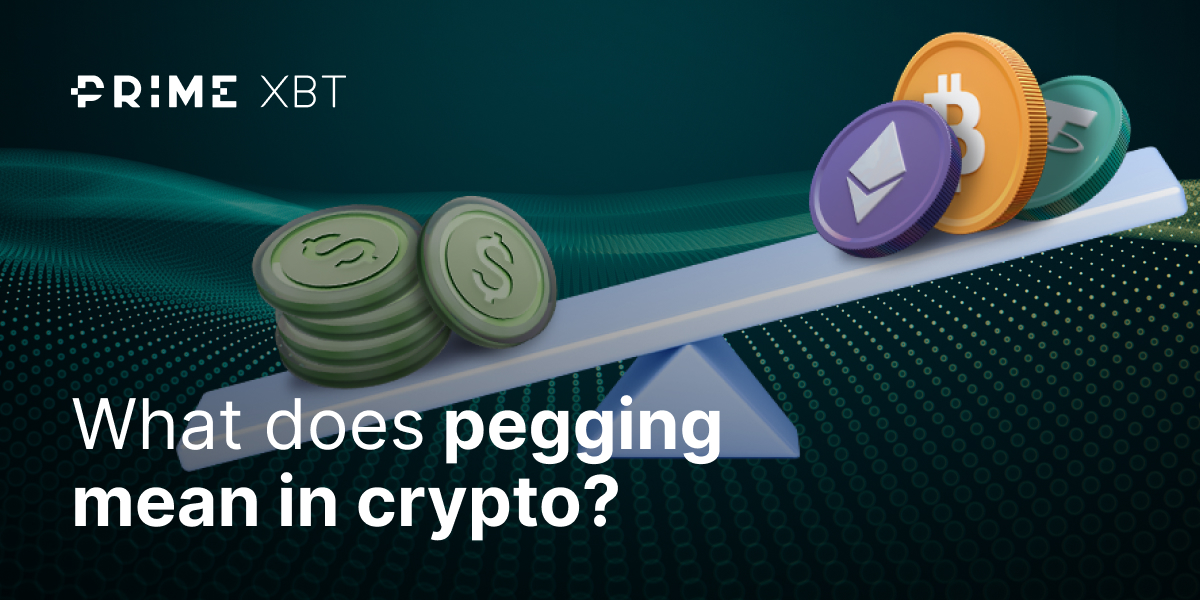The world of Cryptocurrencies is constantly evolving, navigating the sea of terms and concepts can be both exhilarating and perplexing. One such term that frequently surfaces in discussions is “pegging.” But what exactly does pegging mean in the context of Crypto, and why is it a topic of significance?
Pegging in Crypto refers to a strategic practice wherein the value of a digital asset is linked to that of another asset or a combination of assets.
This linkage serves a crucial purpose, aiming to stabilise the often volatile values associated with Cryptocurrencies. Essentially, it provides a tether, grounding the digital asset to a more established reference point, whether it be a fiat currency like the US dollar or a tangible commodity.
In this exploration, we’ll unravel the layers of this concept, examining why pegging is employed, its diverse applications in the Crypto space, and the implications it holds for both seasoned investors and those new to the captivating world of digital assets.
Join us as we demystify the intricacies of Crypto pegging and shed light on its role in shaping the future of decentralised finance.
What does pegging mean in Crypto?

Although a pegged Cryptocurrency might seem like the latest and greatest in the world of finance, a currency peg is nothing new.
Gold, Oil and even some other currencies, have their value pegged to the US dollar.
Much of Fiat money was initially pegged to the value of Gold or Silver, also known as the Gold standard, then they pulled an Uno reverse card and now most precious metals’ values are pegged to the US dollar.
Similarly in the context of Cryptocurrencies, pegging refers to the practice of tying the value of a digital asset to the value of another asset or a basket of assets.
The purpose of pegging is to provide stability to the Cryptocurrency’s value by anchoring it to a more established and less volatile reference point.
Typically, Cryptocurrencies that are pegged to other assets maintain a fixed or relatively stable value compared to the asset they are pegged to.
The asset to which a Cryptocurrency is pegged is often a Fiat currency like the US dollar or a commodity like Gold. This linkage is intended to mitigate the price volatility commonly associated with many Cryptocurrencies, making them more predictable and suitable for various use cases, including as a medium of exchange or a store of value.
In the world of Crypto assets and digital currency pegging involves “tying” a Crypto tokens value to that of a stable currency or underlying asset.
The pegged Cryptocurrency is now a more stable asset following the pegged currency or the underlying asset’s value.
Stablecoins, a specific category of Cryptocurrencies designed to maintain a stable value, often use pegging mechanisms. Pegging provides users with the benefits of digital currencies without exposing them to the extreme price fluctuations seen in some other Cryptocurrencies like Bitcoin and Ethereum.
How does pegging work in Crypto?

Cryptocurrency pegging operates through various mechanisms, each designed to link the value of a digital asset to a more stable reference point, typically a fiat currency or a Commodity. The primary goal is to mitigate the notorious price volatility associated with many Cryptocurrencies.
One common method involves backing the Cryptocurrency with reserves of the asset it is pegged to. For instance, a Stablecoin pegged to the US dollar might hold a reserve of USD in a bank account for every unit of the Stablecoin in circulation. This ensures that the value of the Stablecoin remains close to the value of the US dollar.
Another approach is the algorithmic method, where smart contracts and algorithms dynamically adjust the supply of the pegged Cryptocurrency based on market demand and supply. When demand increases, more units are issued, and when demand decreases, excess units are burned, helping maintain price stability.
Furthermore, there’s the hybrid model that combines both collateralised reserves and algorithmic mechanisms. This approach aims to capitalise on the strengths of both methods, offering a balanced approach to stability.
Pegging can also be achieved through over-collateralisation, where the issuer maintains reserves that exceed the total value of the Cryptocurrency in circulation. This acts as a safety net, providing a buffer against market fluctuations.
In recent times, decentralized finance (DeFi) platforms have explored innovative ways to achieve pegging. These mechanisms often involve decentralized autonomous organizations (DAOs) and algorithmic governance to maintain the pegged value through community consensus and voting.
It’s crucial to note that the effectiveness of pegging mechanisms depends on the transparency of the issuing entity, the strength of the underlying smart contracts, and the market demand for the pegged Cryptocurrency. As the Crypto space continues to evolve, these mechanisms will likely undergo further refinements, contributing to the broader adoption of Stablecoins and pegged Cryptocurrencies in various financial applications.
The pivotal role of smart contracts and oracles in pegged digital currency

Smart contracts and oracles play pivotal roles in maintaining pegs for Cryptocurrencies, particularly in the realm of Stablecoins. These technologies contribute to the automation and decentralized governance necessary for the effective functioning of pegging mechanisms.
1. Smart contracts
Smart contracts are self-executing contracts with the terms of the agreement directly written into code. In the context of maintaining pegs, smart contracts are programmed to enforce the rules and mechanisms that govern the pegging process. Here’s how they contribute:
- Issuance and redemption: smart contracts automate the issuance and redemption of the pegged cryptocurrency. When users want to convert their fiat currency or collateral into the pegged Cryptocurrency, smart contracts handle the process, ensuring transparency and efficiency.
- Algorithmic adjustments: in algorithmic Stablecoins, smart contracts dynamically adjust the token supply based on market conditions. When the price deviates from the peg, these contracts automatically trigger mechanisms to bring the price back in line. For example, if the price is above the peg, the smart contract might mint new tokens, and if it’s below the peg, it might burn existing tokens.
- Collateral management: for Stablecoins backed by collateral, smart contracts manage the collateral reserves. They monitor the value of the collateral and ensure that it remains sufficient to support the peg. If the value falls below a certain threshold, smart contracts may initiate actions such as liquidating collateral or issuing new tokens.
2. Oracles
Oracles act as bridges between the blockchain and the real world by providing external information to smart contracts. In the context of maintaining pegs, oracles supply critical data related to the value of the asset to which the Cryptocurrency is pegged. Here’s how oracles contribute:
- Price feeds: oracles deliver real-time price information from external sources, such as Cryptocurrency exchanges or financial data providers. This information is crucial for smart contracts to assess whether the Cryptocurrency’s value is in line with the peg.
- Decentralized governance: oracles can be used in decentralized governance models to determine key parameters, such as collateralization ratios or the issuance of new tokens. Community members or stakeholders may rely on oracles to make informed decisions based on external data.
The combination of smart contracts and oracles creates a robust infrastructure for maintaining pegs, enabling automation, transparency, and responsiveness to market dynamics in the decentralized finance (DeFi) ecosystem.
Different types of pegged Cryptocurrencies

Pegged Cryptocurrencies come in various types, each employing different mechanisms to maintain their pegs. Here are some prominent types, along with examples and brief explanations of their mechanisms:
Commodity-Backed Stablecoins or Collateralized Stablecoins
- Example: Tether (USDT), USD Coin (USDC), DAI
- Mechanism: these Stablecoins are backed by collateral, which can include fiat currencies, cryptocurrencies, or other assets. For instance, Tether (USDT) claims to be backed 1:1 by the US Dollar. The issuer holds reserves in traditional currencies to ensure the stability of the peg. In contrast, DAI, part of the MakerDAO system, uses over-collateralization in the form of other cryptocurrencies to maintain its peg to the US Dollar.
Algorithmic Stablecoins
- Example: Terra (LUNA), Ampleforth (AMPL)
- Mechanism: algorithmic Stablecoins use smart contracts and algorithmic adjustments to control the token supply and stabilize the price. Terra, for instance, adjusts the supply of its Stablecoin (UST) based on market demand, while Ampleforth uses a unique elastic supply mechanism, adjusting the token supply daily to achieve price stability.
Fiat-backed Stablecoins or Fiat-Collateralized Stablecoins
Example: TrueUSD (TUSD), Paxos Standard (PAX)
- Mechanism: These stablecoins are directly backed by fiat currency reserves, usually held in custodial bank accounts. For instance, TrueUSD claims to be fully backed by US dollars held in escrow accounts. The transparency of the reserve is crucial for building trust among users.
H3: Crypto-backed Stablecoins or Crypto-Collateralized Stablecoins
- Example: sUSD (Synthetix), sEUR (Synthetix)
- Mechanism: similar to fiat-collateralized Stablecoins, but backed by a basket of Cryptocurrencies instead of traditional currencies. sUSD from Synthetix, for example, is backed by a combination of Cryptocurrencies, including Ethereum (ETH) and Synthetix Network Token (SNX), to maintain its peg to the US dollar.
5. Hybrid Stablecoins
- Example: Terra (LUNA), Reserve (RSV)
- Mechanism: combining elements of both collateralized and algorithmic Stablecoins, hybrid Stablecoins aim to leverage the benefits of both approaches. Terra, for instance, employs a dual-token system with LUNA acting as collateral, while RSV by Reserve Protocol combines collateralized assets with an algorithmic stabilization mechanism.
These examples showcase the diverse methods employed by pegged Cryptocurrencies to maintain a stable value. The choice of mechanism depends on factors such as the stability of reserves, decentralization, and the desired level of control over the Stablecoin’s value. Each type aims to address the challenges of price volatility in the dynamic world of Cryptocurrencies.
The Merits and drawbacks of Crypto pegging
Pros of pegging
The biggest benefit is reduced volatility. Pegged Cryptocurrencies aim to minimise price volatility, providing a more stable investment option.
Another benefit is increased trust. Transparency and stability associated with pegged Cryptocurrencies enhance user and investor confidence.
A pegged Cryptocurrency is also more likely to experience mainstream adoption. Stability makes pegged Cryptocurrencies suitable for everyday transactions, fostering broader adoption.
A pegged Crypto also helps more effective risk management. Users can manage risk as the stable value reduces the exposure to the wild way cryptocurrency fluctuates.
It also facilitates cross-border transactions. Stablecoins, in particular, are well-suited for cross-border transactions, offering a consistent reference point for international trade. Since many of the underlying assets that Crypto assets are pegged to are regulated, pegged digital currencies should also be easier to regulate.
Cons of pegging
Centralization concerns: directly backed Stablecoins may face criticism for centralisation, posing a risk if the central entity lacks transparency or encounters regulatory issues.
Dependency on external factors: pegged Cryptocurrencies depend on external factors, such as the stability of the pegged asset or the effectiveness of the pegging mechanism.
Smart contract and oracle risks: Cryptocurrencies using smart contracts and oracles for peg maintenance are exposed to vulnerabilities in these technologies.
Market perception and liquidity risks: confidence in the pegging mechanism is crucial, and a loss of confidence could lead to liquidity issues and impact the Cryptocurrency’s value.
Market fluctuations: during extreme market stress, maintaining the peg can become challenging, especially for collateralized Stablecoins facing sharp declines in collateral value.
What is the best pegged Crypto?
There is a new pegged Cryptocurrency launched almost everyday, put a few standout both due to their underlying asset’s stability and their longevity.
- Tether (USDT): one of the most widely used Stablecoins, claiming to be backed 1:1 by the US dollar.
- USD Coin (USDC): a regulated Stablecoin with transparency and often used in various decentralized finance (DeFi) applications.
- Dai (DAI): part of the MakerDAO system, Dai is pegged to the US dollar and uses a combination of over-collateralization and governance mechanisms to maintain its stability.
- Terra (LUNA): the Terra blockchain has a Stablecoin called TerraUSD (UST) that utilises algorithmic mechanisms for stability.
- sUSD (Synthetix): Synthetix offers a Stablecoin (sUSD) collateralized by a basket of Cryptocurrencies.
- sEUR (Synthetix): Similar to sUSD but pegged to the euro.
- PAX Gold (PAXG): a Stablecoin backed by physical Gold, providing exposure to the stability of the precious metal.
What is Crypto depegging?
I really don’t need to tell you that the Crypto-sphere is in constant flux, and since pegging is a thing the concept of “Crypto depegging” is bound to emerge. The process of depegging, as the name implies, involves the detachment of a Cryptocurrency’s value from its pegged asset, introducing a new dimension of market dynamics. Whether deliberate decisions by project developers or unforeseen challenges to Stablecoins, Crypto depegging has implications for investors, traders, and the broader Crypto community.
What happens when a Stablecoin depegs?
There are numerous observable effects on both the Cryptocurrency that loses its peg and the Cryptocurrency market at large.
Here are just a few of the effects you need to be aware of if you are trading a pegged digital currency and it goes through the process of removing its real value peg.
Market shocks: sudden and severe market shocks can lead to a loss of confidence in the pegging mechanism. Events like significant price fluctuations, regulatory changes, or unexpected market developments may trigger concerns among users.
Insufficient collateral: Cryptocurrencies pegged to collateral may face challenges if the value of the collateral falls sharply. In cases of over-collateralization, a substantial decline can trigger liquidations, impacting the stability of the peg.
Governance issues: depegging can result from governance challenges within decentralized systems. Disputes among token holders, protocol upgrades, or disagreements on how to address market dynamics may lead to depegging.
Lack of transparency: if the issuer lacks transparency about the reserves or collateral backing the pegged Cryptocurrency, doubts may arise regarding the stability of the peg, potentially causing depegging.
Consequently, the consequences of Crypto depegging are significant:
Price volatility: depegging often introduces increased volatility to the Cryptocurrency’s value. Without the anchor of the peg, the token is free to fluctuate based on market forces, potentially experiencing rapid and significant price changes.
Loss of trust: Investors and users may lose trust in the stability and reliability of the Cryptocurrency. Depegging can erode confidence in the project, affecting its reputation within the Crypto community.
Market Confusion: depegging events can lead to confusion in the broader market. Traders and investors may struggle to accurately assess the value of the depegged Cryptocurrency, impacting trading strategies and market dynamics.
Impact on ecosystem: depegging can have broader ecosystem implications, affecting decentralized finance (DeFi) platforms, liquidity pools, and other projects built on or reliant on the depegged Cryptocurrency. Smart contracts and protocols may need adjustments to accommodate the new value dynamics.
Regulatory scrutiny: depending on the reasons for depegging, regulatory authorities may scrutinise the project, especially if there are concerns about transparency, investor protection, or compliance with financial regulations.
Recovery challenges: re-establishing a stable peg after depegging can be challenging. Issuers may need to implement corrective measures, potentially involving adjustments to collateralization ratios, governance structures, or other protocol parameters.
Crypto depegging, while reflecting the dynamic nature of the Crypto space, introduces complexities and uncertainties. Understanding the causes and consequences is crucial for investors, developers, and the broader community to navigate and respond effectively to these events.
The future of Crypto pegs
The trajectory of pegged Cryptocurrencies is subject to various factors, and predicting their future involves uncertainties. However, several trends and possibilities could shape the direction of pegged Cryptocurrencies in the coming years:
Increased adoption will fuel future innovation. As the Cryptocurrency space matures, the adoption of Stablecoins and other pegged Cryptocurrencies will likely increase. Innovations in technology and governance models may further enhance their utility, making them integral components of decentralized finance (DeFi) ecosystems.
An turn towards regulatory developments. Regulatory clarity and acceptance can play a pivotal role. Clearer regulatory frameworks may foster greater confidence in Stablecoins, attracting institutional investors and paving the way for mainstream adoption.
Also improved interoperability between different blockchain networks may become a focus. This could facilitate seamless value transfer and interoperability across various decentralized applications and platforms.
Projects that prioritise transparency may also start emerging, providing real-time auditing mechanisms and clear information about collateral reserves, may gain a competitive edge. Transparency is crucial for building trust among users and investors.
Hybrid Stablecoins combining elements of collateralization and algorithmic stabilization may emerge. These models aim to balance the benefits of collateral backing with the flexibility and efficiency of algorithmic adjustments.
As their value increases, Stablecoins maybe adopted into traditional financial systems could lead to broader use cases, including cross-border payments, remittances, and as a stable store of value.
The Stablecoin landscape is highly competitive, with various projects vying for market share. Projects that can effectively address issues related to scalability, security, and user experience may lead the way. Competition often results in net benefits to the end user…that’s you!
Even though it seems like the growth horizon for pegged digital currency is far way, the space may face challenges, including regulatory scrutiny, technological vulnerabilities, and risks associated with the collateralization of Stablecoins. Successfully navigating and mitigating these challenges will be crucial for the sustained growth of pegged cryptocurrencies.
It’s essential to recognize that the Cryptocurrency space is dynamic, and developments can occur rapidly. Market sentiment, technological advancements, and regulatory shifts will all play roles in shaping the future of pegged Cryptocurrencies. Continuous monitoring of industry trends and staying informed about regulatory changes will be key for stakeholders in this evolving landscape.
The content provided here is for informational purposes only. It is not intended as personal investment advice and does not constitute a solicitation or invitation to engage in any financial transactions, investments, or related activities. Past performance is not a reliable indicator of future results.
The financial products offered by the Company are complex and come with a high risk of losing money rapidly due to leverage. These products may not be suitable for all investors. Before engaging, you should consider whether you understand how these leveraged products work and whether you can afford the high risk of losing your money.
The Company does not accept clients from the Restricted Jurisdictions as indicated in our website/ T&C. Some services or products may not be available in your jurisdiction.
The applicable legal entity and its respective products and services depend on the client’s country of residence and the entity with which the client has established a contractual relationship during registration.




